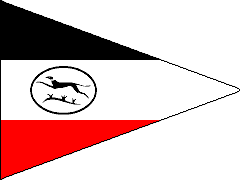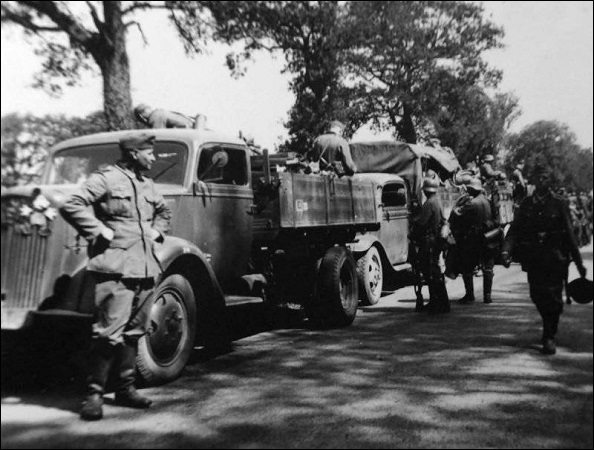NOTE ON
NOMENCLATURE
Motorized infantry divisions of the German Army were titled
Infanterie-Division
(motorisiert).
Lower-echelon motorized infantry elements were
the Infanterie-Regiment (motorisiert), the Infanterie-Bataillon (motorisiert) and the Kradschützen-Batallion
(motorcycle rifle battalion). The
Aufklärungs-Abteilung (retitled Panzer-Aufklärungs-Abteilung
in early 1940)
was the divisional reconnaissance battalion and the
Panzer-Abwehr-Abeiling
(retitled
Panzerjäger-Abteilung in early
1940) was the divisional antitank
battalion. Other divisional units, such as artillery
regiments and signal battalions, had
motorisiert
appended to their titles, e.g. 72. Artillerie-Regiment (motorisiert)—often
abbreviated to (mot).
● ● ●
In
1939 the German Army’s order of battle included four
motorized infantry divisions. These were standard
1st Wave Infantry
Divisions with all elements motorized. Their
official establishment was 16,445 men as against 17,734 for
the standard division, a difference attributable to the
lower manpower requirements for motor vehicles versus
horses. The motorized infantry divisions were intended to
operate alongside
panzer divisions under a motorized corps
headquarters. However, only one motorized corps was so organized
during the Polish campaign; it embodied a panzer division
and two motorized infantry divisions.
Experience gained in Poland disclosed certain shortcomings
of the motorized infantry divisions. First, they were not as
mobile as the panzer divisions, mostly relying as they did on
wheeled vehicles with marginal off-road
performance. Second, with three regiments—nine battalions of
infantry—they were unwieldy, taking up too much road space
and causing bothersome traffic congestion. The latter
problem was solved by removing one infantry regiment and one
field artillery battalion from each division, but the
mobility problem proved intractable. The obvious solution
was to replace the trucks with tracked or half-tracked
vehicles, especially for the infantry. But during the war
German industry never succeeded in producing the necessary
vehicles in sufficient numbers—and the panzer divisions had
first call on those that were produced.
In
Western Europe with its well-developed road net the mobility
problem was not so serious, and the motorized infantry
divisions gave a good account of themselves in the 1940
campaign. But the USSR was a very different proposition.
There good roads were relatively few and the climate—extremely
cold and snowy in winter, wet and muddy in spring and
autumn—frequently brought all motorized movement to a halt.
The long distances to be covered and the generally primitive
conditions on the Eastern Front also increased wear and tear
on vehicles of all types, especially trucks hauling supplies
and troops for long distances over poor roads.

Command flag, 16. Infanterie-Division
(mot.)
At the
beginning of the Russian campaign (22 June 1941) the motorized infantry
division had the configuration shown in the accompanying
diagram. To bolster its infantry contingent, a separate
motorcycle infantry battalion had been added. This battalion
was similar to the standard motorized infantry battalion,
with motorcycles replacing most trucks and a heavy company
with 2 x 75mm infantry guns (IG), 3 x 37mm antitank
guns (ATG) and a pioneer (combat engineer) platoon added.
The divisional antitank (AT) battalion now had 9 x 50mm ATG and
24 x 37mm ATG, plus an flak (antiaircraft) company with 2 x
quadruple 20mm antiaircraft guns (AAG) and 8 x single 20mm
AAG, all self propelled. The regimental AT
companies, however, still had to make do with the 37mm ATG.
This gun was quite ineffective against the Red Army's medium
and heavy tanks, as indicated by the derisive nickname given
it by the troops: "the infantry's door knocker." Even the
more powerful 50mm ATG was no more than marginally effective against KV and T34 tanks. Thus the Germans frequently
found it necessary to bring up a 105mm gun or howitzer from
the division artillery to deal with such heavy armor.
The
standard artillery regiment for motorized infantry divisions
now had two light battalions, each with 12 x 105mm howitzer,
and one medium battalion with 12 x 150mm howitzer. Two
divisions, however, had a medium artillery regiment with 8 x
150mm howitzer and 4 x 105mm gun. All howitzers and guns
were halftrack towed.
The
armored reconnaissance battalion, a key unit of the
division, had an armored car company, a motorcycle
infantry company, and a heavy company with 2 x 75mm IG, 3 x
37mm ATG, and a pioneer platoon. The
battalion was well provided with long- and short-range
radios to facilitate communications both internally and with
higher headquarters. Being
equipped with wheeled vehicles, however, its mobility
proved
inadequate for the Eastern Front. It was therefore planned
to replace the wheeled armored cars and motorcycles with
variants of the SPW 250 light armored halftrack. But these
new vehicles were never produced in sufficient numbers fully
to refit all armored reconnaissance battalions, so the
wheeled armored cars had to soldier on.

The German Army's standard cargo truck,
the Opel Blitz. There were never enough of them (Bundesarchiv)
Ten
motorized infantry divisions were available by June 1941 and
thanks to the aforementioned equipment shortages they were not
identically organized. The divisions' two motorized infantry
regiments were supposed to be equipped with the standard
four-wheel-drive military truck, the Opel Blitz, but these
could not be produced in sufficient numbers. Thus three divisions received trucks
captured from the British and French armies, notwithstanding
the associated logistical and maintenance problems. The
light flak company
was present in the AT battalions of only three divisions—the
others received it later—and two divisions lacked the
motorcycle infantry platoons specified for their motorized
infantry regiments. Full standardization was never really
achieved, since when divisions were refitted or new ones
were raised, they got whatever weapons and equipment were
available at the time.
The
battles in Russia from June to December 1941 took a heavy
toll of the whole German Army, with particularly severe
losses among the mobile divisions. Thousands of vehicles of
all types were destroyed or abandoned in the snow during the
crisis produced by the Red Army’s winter counteroffensive,
and when the fighting finally died down the motorized
infantry divisions were motorized in name only. By the
spring of 1942 the Army on the Eastern Front was 75,000
vehicles short and OKH (Army High Command) estimated that
new production and captured or requisitioned civilian
vehicles could replace only half that number in time for the 1942 campaign. It would be
necessary, OKH added, to strip the ordinary infantry
divisions of most of their motor vehicles so as to provide
for the panzer and motorized divisions earmarked
for the planned summer offensive in the southern USSR.
Motorized units stationed in the northern and central
sectors of the Eastern Front had also to give up a
proportion of their vehicles. All these measures enabled the
motorized infantry divisions allotted to Army Group South to
be restored to fighting trim by the
spring of 1942, though at the expense of those stationed elsewhere.
● ● ●